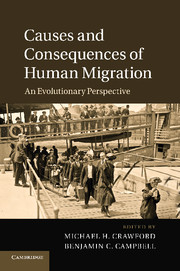Book contents
- Frontmatter
- Contents
- Contributors
- Preface
- 1 Perspectives on human migration: introduction
- Section 1 Theory
- Section 2 Geography and migration
- 8 Population structure and migration in Africa: correlations between archaeological, linguistic, and genetic data
- 9 Human migrations in North Africa
- 10 Identity, voice, community: new African immigrants to Kansas
- 11 The African colonial migration into Mexico: history and biological consequences
- 12 Demic expansion or cultural diffusion: migration and Basque origins
- 13 Consequences of migration among the Roma: immunoglobulin markers as a tool in investigating population relationships
- 14 Migration, assimilation, and admixture: genes of a Scot?
- 15 Mennonite migrations: genetic and demographic consequences
- 16 Human migratory history: through the looking-glass of genetic geography of Mycobacterium tuberculosis
- 17 Peopling the Tibetan plateau: migrants, genes, and genetic adaptations
- 18 Migration, globalization, instability, and Chinese in Peru
- 19 The great blue highway: human migration in the Pacific
- 20 Migration of pre-Hispanic and contemporary human Mexican populations
- 21 A review of the Tupi expansion in the Amazon
- 22 Molecular consequences of migration and urbanization in Peruvian Amazonia
- 23 Migration in Afro-Brazilian rural communities: crossing historical, demographic, and genetic data
- 24 Indentured migration, gene flow, and the formation of the Indo-Costa Rican population
- 25 Causes and consequences of migration to the Caribbean Islands and Central America: an evolutionary success story
- Section 3 Overview
- Index
- References
14 - Migration, assimilation, and admixture: genes of a Scot?
Published online by Cambridge University Press: 05 December 2012
- Frontmatter
- Contents
- Contributors
- Preface
- 1 Perspectives on human migration: introduction
- Section 1 Theory
- Section 2 Geography and migration
- 8 Population structure and migration in Africa: correlations between archaeological, linguistic, and genetic data
- 9 Human migrations in North Africa
- 10 Identity, voice, community: new African immigrants to Kansas
- 11 The African colonial migration into Mexico: history and biological consequences
- 12 Demic expansion or cultural diffusion: migration and Basque origins
- 13 Consequences of migration among the Roma: immunoglobulin markers as a tool in investigating population relationships
- 14 Migration, assimilation, and admixture: genes of a Scot?
- 15 Mennonite migrations: genetic and demographic consequences
- 16 Human migratory history: through the looking-glass of genetic geography of Mycobacterium tuberculosis
- 17 Peopling the Tibetan plateau: migrants, genes, and genetic adaptations
- 18 Migration, globalization, instability, and Chinese in Peru
- 19 The great blue highway: human migration in the Pacific
- 20 Migration of pre-Hispanic and contemporary human Mexican populations
- 21 A review of the Tupi expansion in the Amazon
- 22 Molecular consequences of migration and urbanization in Peruvian Amazonia
- 23 Migration in Afro-Brazilian rural communities: crossing historical, demographic, and genetic data
- 24 Indentured migration, gene flow, and the formation of the Indo-Costa Rican population
- 25 Causes and consequences of migration to the Caribbean Islands and Central America: an evolutionary success story
- Section 3 Overview
- Index
- References
Summary
Introduction
During the last four centuries, millions of Scots have left the British Isles as a result of push factors including overpopulation, religious persecution, and political and economic upheaval. Many of these individuals found their way to the Americas, where the promise of land and opportunities in trades such as tobacco, sugar, and textiles offered a better way of life and outweighed the costs and dangers of a trans-Atlantic journey (Landsman, 1999). Scots began to arrive in the American colonies during the 1600s, and have contributed much to the American culture that exists today. In the 2006 American Community Survey, the United States Census Bureau reported over 6 million Americans (1.7% of the total population) claimed Scottish ancestry. Another 5.3 million (1.5% of the U.S. population) claimed a Scotch–Irish ancestry, a term usually indicating descent from the estimated 100 000 Scots that left the Scottish lowlands for the Irish Province of Ulster during the 1600s, and migrated to North America some five generations later (Houston, 1996). There are an estimated 24 million (estimated from D.A. Bruce, 1998) or so individuals around the world who claim Scottish ancestry despite having never seen Scotland itself. How and why an individual identifies with a particular ethnic group after being removed from their “homeland” for several generations has long been a perplexing question. This chapter describes the movement of Scots to the Americas, the genetic structure and diversity seen within Scotland, and presents the maternal and paternal genetic markers of a group of Americans who claim Scottish ancestry, to show how molecular markers can be used to illustrate the migratory behaviors of humans.
Causes of migration to the Americas
Immigration to the New World colonies began in the 1600s and by 1700 some 6000 Scots had arrived (Fogleman, 1992; Houston, 1996).
- Type
- Chapter
- Information
- Causes and Consequences of Human MigrationAn Evolutionary Perspective, pp. 269 - 298Publisher: Cambridge University PressPrint publication year: 2012



